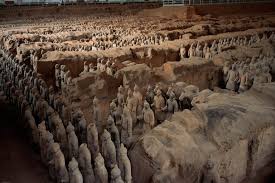
Whose Tomb Are the Terracotta Army Buried In?
The Silent Guardians of a Mighty Emperor: The Terracotta Army
Deep within the heart of China lies an army frozen in time. Thousands of life-sized terracotta warriors, each unique in their appearance, stand guard over a vast necropolis. This is the Terracotta Army, a testament to the power and ambition of its owner – Qin Shi Huang, the first emperor of China.
A Life's Work: The Construction of Qin Shi Huang's Mausoleum
Upon ascending the throne at the tender age of 13, Qin Shi Huang embarked on a monumental task – the construction of his own mausoleum. Driven by a belief in his own immortality and a desire to rule even in the afterlife, the young emperor dedicated vast resources and manpower to this project. The construction spanned decades, continuing even after he unified China in 221 BC and declared himself emperor, a title that would echo through millennia.
A City of the Dead: The Scale of Qin Shi Huang's Necropolis
The sheer scale of Qin Shi Huang’s mausoleum is staggering. Encompassing an area of over 50 square kilometers, it’s a sprawling complex of palaces, tombs, and underground chambers. At its heart lies the emperor's burial mound, yet to be excavated but believed to contain unimaginable treasures.
Protecting this city of the dead is the Terracotta Army, stationed in vast pits located about a mile east of the emperor’s tomb. These are not mere statues, but meticulously crafted figures, each with individualized features and equipped with real weapons. The sheer number is awe-inspiring, with estimates reaching over 8,000 soldiers, 130 chariots with 520 horses, and 150 cavalry horses.
The Legacy of Qin Shi Huang
Though he ruled with an iron fist, Qin Shi Huang is credited with unifying China and laying the foundation for its future. His mausoleum, with its silent army, stands as a testament to his ambition and the power he wielded. It is a window into the past, revealing the grandeur and artistry of ancient China, and the lengths to which a ruler would go to prepare for the afterlife.
Q&A
Q: When was the Terracotta Army discovered?
A: The Terracotta Army was discovered in 1974 by farmers digging a well in Lintong District, Xi'an, Shaanxi province, China.
Q: Why was the Terracotta Army built?
A: The Terracotta Army was built to accompany Qin Shi Huang, the first emperor of China, in the afterlife. They were intended to protect him and ensure his power continued even after death.
Q: Is Qin Shi Huang’s tomb open to the public?
A: No, the central tomb of Qin Shi Huang remains unopened. Archaeologists are hesitant to disturb the tomb due to concerns about preserving the artifacts inside and the potential presence of dangerous traps.